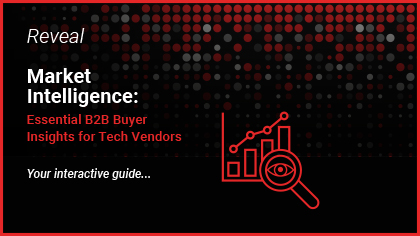By 2019, programmatic advertising will most probably account for about two-thirds of the world’s digital display advertising (martechcube).
There’s no doubt programmatic advertising is one of the fastest growing areas of AdTech, connecting advertisers with publishers to get targeted, relevant content in front of the most appropriate audience demographics, effectively and seamlessly.
However, whilst the value of programmatic ads for B2C campaigns is already well known, the B2B market as a whole has been much slower on the uptake. Why is this?
Market research suggests the progression of programmatic’s journey into the B2B market has been hampered by inhibiting factors such as lack of value chain transparency, concerns over brand safety, and effective B2B audience targeting (Dun & Bradstreet).
All of these factors combined mean, even some of the most progressive and forward-thinking B2B marketing specialists have held off on dedicating some of their ad budget to programmatic. But in an aggressively competitive B2B landscape where tech has created an even playing field for businesses for all sizes – what’s the cost of late programmatic adoption?
The insidious forwards march of programmatic AdTech waits for no one, and with industry big hitters such as LinkedIn now offering prime ad real estate via programmatic, B2B marketers who aren’t exploring their options in this area are likely to get left behind – fast (LinkedIn).
So, how can B2B marketers get ready for programmatic advertising? We’ll answer this question and cover some of the key points worth considering, within this article.
The main limitations of programmatic for B2B marketing
Whilst B2C programmatic is thriving and growing year on year, B2B’s growth within the programmatic sphere has been somewhat slower and more speculative.
This is in large part due to the inherent challenges that programmatic can pose to B2B ad buyers, leading to a state of extreme cautiousness across the market as a whole.
3 core challenges and potential limitations of B2B programmatic include:
- B2B audience targeting.
42% of B2B marketers cited targeting the right audience as their number 1 challenge for programmatic (Dun & Bradstreet).
B2B-specific audience targeting – or a lack of it – has historically been a significant challenge for B2B ad buyers. Getting high-value B2B publishers on board with offering programmatic ad space is something that remains an issue, particularly among smaller and niche publishers.
This has resulted in limitations on the number of viable publisher channels available to B2B advertisers, which a survey by Ad Exchanger determined has resulted in 85% of B2B programmatic advertisers targeting their demographics via a combination of B2B and B2C platforms.
However, it appears the tides are turning…
With the rapid growth of data-driven targeting strategies deployed by marketers, account-based marketing (ABM) is driving demand for programmatic advertising. Buying platforms, data providers and publishers formally the preserve of B2C marketers are now responding to this demand, opening up new opportunities for B2B marketers to extend their advertising ecosystem (Forrester).
- Lack of value chain transparency.
The ability to track hard data and identify direct correlations between programmatic ad spend and a resulting uptick in sales or acquisitions is something else that has long frustrated B2B marketers, who are highly data-driven and usually less able to justify ad spend without hard results to support it.
Better communication and understanding of key metrics between internal teams, ad agencies and ad tech partners is one way to combat to transparency issues. By mapping the whole ecosystem, assigning key performance indicators (KPIs) and using a data-driven algorithms to forecast and monitor spend, many perceived transparency issues can be resolved.
In fact, 23. 90% of B2B brands and agencies believe the use of data and analytics is changing how they approach advertising and marketing (Dun & Bradstreet).
Additionally, the desires of B2B marketers to deal with hard data to demonstrate value chain transparency is another call that programmatic ad agencies have responded to, with the majority of programmatic ad exchanges that target the B2B market integrating comprehensive data management platforms with CRM and MA functionality built in.
- Brand safety.
Programmatic ads have an industry-wide standard of 16% fraud – which is lower than other display ads (Digital Marketing Institute).
However, concerns over brand safety is perhaps the biggest sticking point for B2B marketers considering programmatic ad real estate – because programmatic ad buying is automated, exactly how and where brand ads appear is something that buyers have only a limited level of control over. Historically, this has resulted in some highly damaging and well-publicized automated brand ad placements – such as the placement of Mercedes Benz ads within YouTube videos created by both neo-Nazi organisations and Islamic extremists (The Times).
In response to transparency and brand safety concerns, 51% of marketers have aggressively updated blacklists and 45% have targeted whitelists. (ANA/Forrester). Whilst the AdTech industry as a whole works towards promoting brand safety and building trust through advocating best practice guidelines to all parties in the interactive advertising landscape (IAB).
The growth of programmatic advertising within the B2B marketing sphere
Adoption rates for programmatic within the B2B sphere is on the rise – both in terms of advertisers and the publishers that are partnering up with programmatic ad exchanges to meet the ever-increasing demand, and the amount of ad spend that B2B marketers are willing to dedicate to programmatic (Marketing Profs).
A niche market of programmatic ad exchanges dedicated to serving B2B buyers has also developed, such as BPA’s hallmark B2B Exchange, a closed marketplace for B2B media buying. LinkedIn’s move over to the programmatic selling of their own ad real estate, which began in 2016, is another benchmark of the B2B market’s increasing desire to enter the programmatic arena.
Ultimately, for B2B marketing to fully embrace programmatic ad buying, programmatic publishers and ad exchanges still have some way to go when it comes to providing the necessary data B2B marketers want and need before they will consider spending significant amounts of money on programmatic ad placement.
Scalability is another issue – for B2C programmatic, the potentially desirable audience demographics are wide and diverse, whilst for B2B, bespoke targeting of a much smaller niche with a high level of accuracy is naturally vastly more important than simply reaching a large subset of a certain demographic of the population.
B2B marketing buyers are willing to pay for exposure when their desired audiences can be targeted accurately, but the value has to be there to make this spend worthwhile.
Despite this, programmatic for B2B is on the up regardless, and AdWeek BrandShare reports that 63% of B2B marketers planned to increase their programmatic ad spend this year.
So, is B2B marketing ready for programmatic to really take off?
The rapid increase in sales of our own programmatic advertising solution InboxNEXUS, suggests brands have already hit the ground running. For more information on how you can take the plunge, check out InboxNEXUS here.







